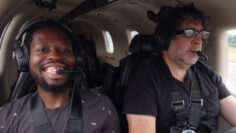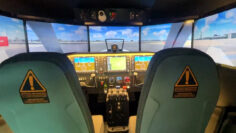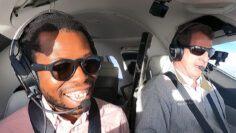What Is Commercial Aviation?

Commercial aviation refers to the part of the aviation industry that involves using aircraft for transporting passengers, cargo, or mail on a commercial basis. It includes activities like running airlines, managing airports, controlling air traffic, and ensuring regulatory compliance.
Importance of Commercial Aviation Commercial Aviation
plays a crucial role in connecting people, facilitating global trade, and promoting tourism. It provides fast and efficient transportation, allowing businesses to expand their reach and individuals to explore new places. Additionally, commercial aviation contributes to economic growth by creating jobs, generating revenue, and supporting related industries like aerospace manufacturing and tourism.

Brief History of Commercial Aviation
The first successful powered flight by the Wright brothers in 1903 marked the beginning of a new era. Aviation pioneers such as Louis Blériot and Charles Lindbergh pushed the boundaries of air travel. The commercial aviation industry took off in the 1920s with the establishment of airlines and the introduction of commercial passenger flights. Over time, advancements in aircraft technology, infrastructure development, and regulatory frameworks led to the growth and globalization of commercial aviation as we know it today.
Key Components of Commercial Aviation
Airlines
Types of Airlines
- Full-Service Airlines: These offer a range of services to passengers, including in-flight meals, entertainment, and baggage allowances.
- Low-Cost Carriers: LCCs focus on providing affordable fares by simplifying their business models and eliminating non-essential services.
- Regional Airlines: These airlines primarily operate shorter flights within specific regions, connecting smaller airports to major hubs.
Fleet Composition Airlines operate a variety of aircraft in their fleets. Narrow-body aircraft like the Boeing 737 and Airbus A320 are commonly used for domestic and short-haul flights, while wide-body aircraft like the Boeing 777 and Airbus A350 are used for long-haul and international routes.
Airports
Types of Airports
- International Airports: These airports serve as major gateways for international travel, connecting multiple destinations.
- Domestic Airports: Domestic airports primarily handle flights within a specific country or region.
- Regional Airports: Regional airports cater to smaller aircraft and connect remote or less populated areas.
Airport Infrastructure Airport infrastructure includes runways, taxiways, terminals, and facilities like control towers, hangars, and cargo handling areas. Airports also provide ground transportation services, parking facilities, and amenities for passengers.
Airport Operations Airport operations involve various activities such as aircraft ground handling, passenger check-in, security screening, baggage handling, aircraft maintenance, and coordination with air traffic control.
Air Traffic Control (ATC)
The role of ATC Air traffic control ensures the safe and efficient movement of aircraft within controlled airspace. ATC controllers provide instructions and guidance to pilots, ensuring proper separation between aircraft and facilitating smooth takeoffs, landings, and routing during flights.
ATC Systems and Technology ATC rely on radar, communication systems, navigation aids, and advanced software to monitor and control aircraft. Technologies like Automatic Dependent Surveillance-Broadcast (ADS-B) and Collaborative Decision Making (CDM) enhance situational awareness and optimize air traffic management.
Regulatory Bodies
International Civil Aviation Organization(ICAO) ICAO, a specialized agency of the United Nations, establishes international standards and regulations for aviation safety, security, efficiency, and environmental protection.
Federal Aviation Administration (FAA) It oversees aircraft certification, pilot licensing, air traffic control, and safety regulations.
European Union Aviation Safety Agency (EASA) EASA is responsible for aviation safety in the European Union. It harmonizes regulations, conducts safety inspections, and certifies aircraft and airlines.
Commercial Aviation Operations
Flight Planning and Scheduling
Route Selection Airlines plan routes considering factors like airspace restrictions, weather conditions, fuel efficiency, and traffic flow to determine the most efficient and cost-effective paths.
Flight Planning Process Flight planning involves calculating fuel requirements, considering aircraft performance, and determining optimal altitudes and speeds. Airlines also coordinate with air traffic control and consider airport slot allocations for timely departure and arrival.
Crew Scheduling Airlines schedule flight crews to comply with rest requirements and ensure sufficient staffing. Factors like flight time limitations, pilot qualifications, and crew availability are taken into account.
Aircraft Operations
Pre-flight Checks Before each flight, pilots and ground crew perform thorough pre-flight checks to ensure the aircraft’s airworthiness. These checks include inspections of the exterior, interior, control systems, fuel levels, and emergency equipment.
Takeoff and Landing Procedures Pilots follow specific procedures for takeoff and landing, communicating with air traffic control, conducting runway inspections, and adhering to speed and altitude restrictions. Takeoff and landing are critical phases of flight that require careful coordination and adherence to safety protocols.
In-flight Operations During the flight, pilots monitor aircraft systems, maintain communication with air traffic control, and make necessary adjustments for a smooth and safe journey. They also handle any in-flight emergencies or abnormal situations that may arise.
Passenger Services
Ticketing and Reservations Passengers can book tickets through various channels, including airline websites, travel agents, and online travel agencies. Airlines manage reservation systems to track passenger information, issue tickets, and allocate seats.
Check-in and Boarding Passengers can check in for their flights via mobile applications or airport counters. Boarding procedures involve security checks, verifying travel documents, and organizing the boarding process based on seat zones or boarding groups.
In-flight Services Airlines provide various onboard services such as meals, beverages, entertainment systems, and Wi-Fi connectivity. Cabin crew members ensure passenger comfort, assist with inquiries, and manage in-flight safety procedures.
Baggage Handling Airlines have systems to efficiently transport passengers’ checked and carry-on baggage. Baggage is screened for security purposes, labelled, and loaded onto the aircraft, with processes in place to ensure correct delivery at the destination.
Safety and Security Measures
Aircraft Maintenance Airlines adhere to strict maintenance schedules and procedures to ensure the airworthiness and reliability of their aircraft. Regular inspections, maintenance checks, and repairs are carried out to meet regulatory requirements and ensure passenger safety.
Safety Regulations and Inspections Regulatory bodies enforce safety regulations and conduct inspections to ensure compliance. Airlines undergo safety audits that assess operational procedures, maintenance records, training programs, and adherence to safety standards.
Security Screening Airports implement security screening procedures to prevent unauthorized items from being carried onto aircraft. Passengers and their belongings undergo screening using metal detectors, X-ray machines, and other technologies to detect potential threats.
Commercial Aviation Challenges
Environmental Impact
Carbon Emissions Commercial aviation contributes to greenhouse gas emissions primarily through aircraft engines. Airlines and regulatory bodies are working actively to reduce emissions by improving fuel efficiency, enhancing aircraft design, and promoting the use of sustainable aviation fuel (SAF).
Noise Pollution Airports and airlines implement measures to minimize the impact of aircraft noise on surrounding communities. This includes using quieter aircraft, optimizing flight paths, and implementing land use planning around airports.
Sustainable Aviation Fuel The development and adoption of sustainable aviation fuel (SAF) are crucial for reducing aviation’s carbon footprint. SAF is produced from renewable sources and provides a more sustainable alternative to conventional jet fuel.
Safety and Security
Accidents and Incidents Commercial aviation are one of the safest modes of transportation, but accidents and incidents can still occur. Safety initiatives, rigorous training programs, and advancements in aircraft design and maintenance practices help mitigate risks and enhance safety.
Terrorism Threats Commercial aviation faces the ongoing challenge of terrorism threats. Airlines and security agencies collaborate to implement robust security measures, including passenger screening, cargo security, and intelligence sharing, to prevent and respond to potential threats.
Cybersecurity As commercial aviation increasingly relies on digital systems, cybersecurity risks become more prominent. Protecting critical aviation infrastructure, flight systems, and passenger data from cyber threats is crucial. Airlines and regulatory bodies continually enhance cybersecurity measures to stay ahead of evolving threats.
Economic Factors
Fuel Costs Fuel costs significantly impact airline profitability. Fluctuating oil prices and geopolitical factors can result in fuel expense volatility, affecting airline operations and ticket prices.
Competition and Pricing The commercial aviation industry is highly competitive, with airlines striving for market share. Pricing strategies, fare structures, and customer loyalty programs play essential roles in attracting passengers and maintaining profitability.
Global Economic Conditions The aviation industry is sensitive to global economic conditions. Economic downturns, recessions, or geopolitical events can affect passenger demand, resulting in revenue fluctuations for airlines.

Frequently Asked Questions
What are the busiest airports in the world?
-
- Hartsfield-Jackson Atlanta International Airport (ATL)
- Beijing Capital International Airport (PEK)
- Los Angeles International Airport (LAX)
- Dubai International Airport (DXB)
- Tokyo Haneda Airport (HND)
How are airline tickets priced?
Airline ticket prices are influenced by several factors, including demand, competition, operating costs, and market conditions. Pricing models consider factors such as passenger demand forecasts, route profitability, and the competitive landscape. Pricing strategies can involve dynamic pricing, yield management, and fare classes.
How does air traffic control manage multiple aircraft?
Air traffic control manages multiple aircraft through a combination of procedural and radar-based control systems. Air traffic controllers use radar displays, communication systems, and advanced software to track aircraft positions, provide instructions for altitude and speed changes, and ensure safe separation between aircraft. They coordinate departures, arrivals, and routing to ensure efficient and safe air traffic flow.
Conclusion
Commercial aviation is a dynamic and multifaceted industry that connects people, drives global trade, and fosters economic growth. It has transformed the way we travel and conduct business, bridging distances and cultures. The future of commercial aviation holds promise as advancements in technology, sustainability, and safety continue to shape the industry. However, challenges such as environmental impact, safety and security concerns, and economic fluctuations must be addressed through collaboration and innovation.
Get Engaged
Share your thoughts on commercial aviation We value your insights and perspectives on commercial aviation. Are there specific aspects of the industry that fascinate or concern you? Do you have any memorable travel experiences? Or perhaps you have questions about specific aspects of commercial aviation? Comment below with your experiences or questions. Also, Read our recent article on “What Is Air Traffic Control”. Gain a deeper understanding of the critical role air traffic control plays in ensuring safe and efficient air travel.






